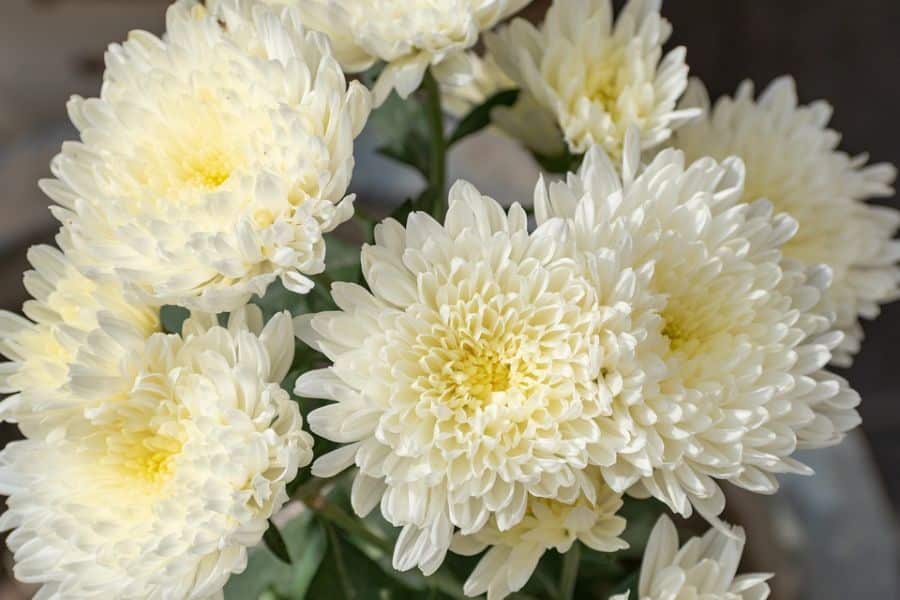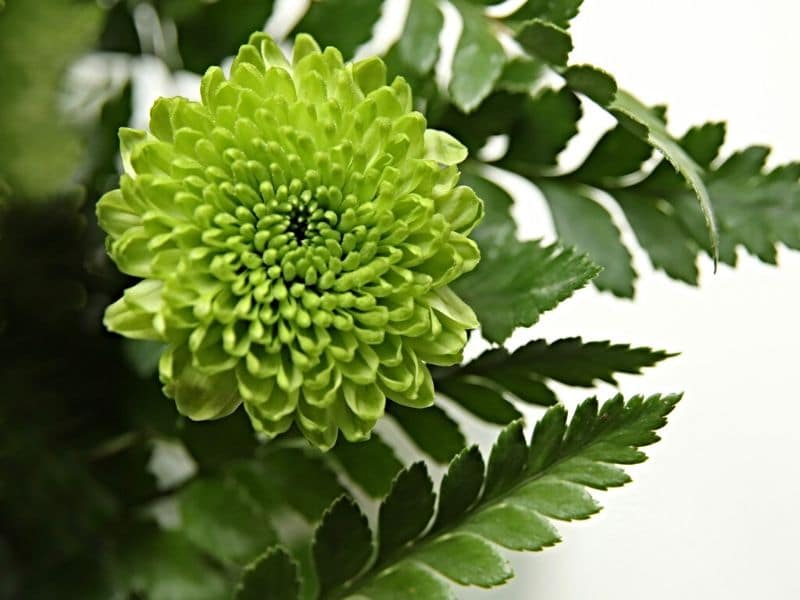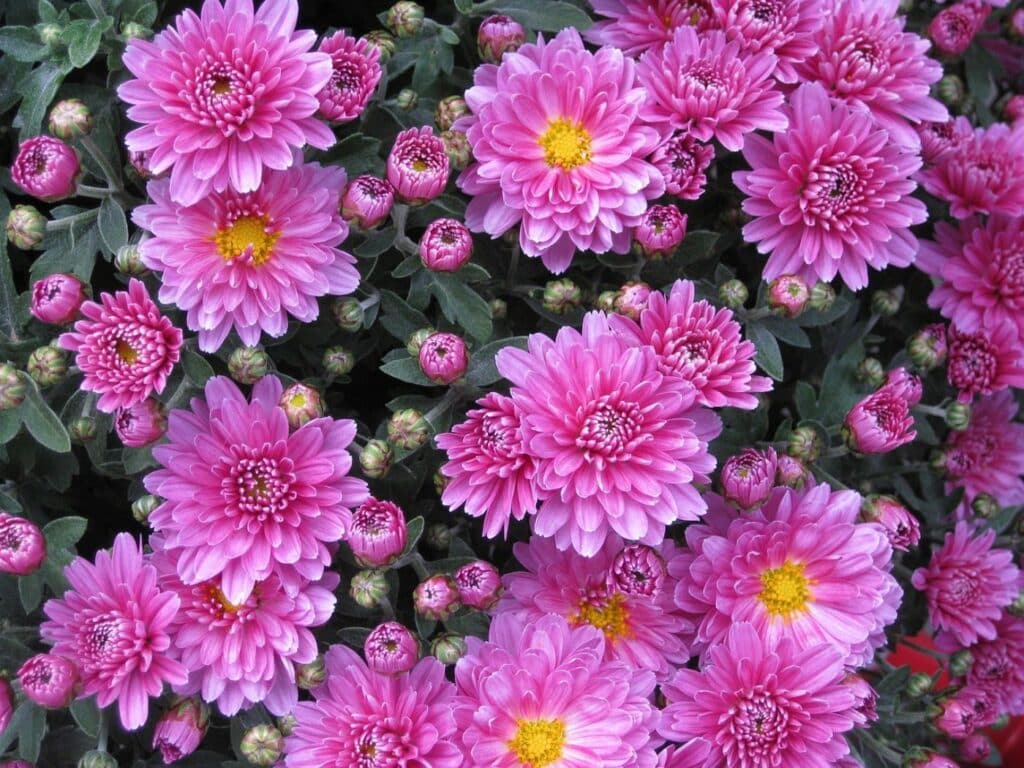You’ve been nurturing your mums with the utmost care, but they seem to be struggling. Could it be that you’re killing them with kindness? Overwatering is a common issue that can lead to wilting, yellow leaves, and ultimately, the death of your beloved plants.
In this article, we’ll delve into the signs of overwatered mums, the damage it can cause, and most importantly, how to rectify the situation. Get ready to transform your gardening approach and help your mums thrive like never before.
Recognizing the Signs of Overwatered Chrysanthemum
It’s crucial to be able to pick out the signs of overwatering to take quick corrective actions for your mums. Let’s look at some common symptoms that indicate overwatering.
Yellowing Leaves
You may notice the leaves of your mum turning yellow. It’s not a natural transition but a visible sign of water stress. Too much water often suffocates the roots, inhibiting their ability to absorb crucial nutrients, causing the leaves to yellow before dropping off entirely.
Wilting Despite Wet Soil
One perplexing characteristic of overwatered chrysanthemums is wilting when the soil is still wet. You may well find this confusing – the soil’s drenched, but your mums are wilting as if parched. It’s an indication that the roots are drowning and unable to draw up water to support the plant’s structural stability.
Mold or Algae on the Surface
If your mums are getting more water than they can handle, you may see mold or algae forming on the soil surface. Not only is this a clear sign of overwatering, but it can also lead to additional problems such as root rot, hampering your plant’s growth and vitality.
By recognizing these signs, you can adjust watering practices and save your chrysanthemums from unnecessary stress.
Understanding the Consequences of Overwatering

It’s crucial to grasp the negative impacts that overwatering mums can have. This excess moisture can lead to a array of issues that detrimentally affect plant health and growth.
Root Rot
The primary consequence of overwatering is root rot. When drenched constantly, the plant’s roots lack necessary oxygen leading to their decay. This condition significantly affects the plant’s ability to absorb important nutrients from the soil.
Root rot manifests itself through wilted, discolored leaves and a stunted growth, often mistaken for under-watering.
Increased Susceptibility to Diseases
An overwatered mum becomes more susceptible to diseases. The wet environment serves as a perfect breeding ground for various fungi and bacteria. For example, an overwatered mum may well fall victim to leaf spot disease, caused by the fungus Septoria chrysanthemi, which creates dark spots on the foliage.
Stunted Growth
Lastly, overwatered mums suffer from stunted growth. Waterlogged soil inhibits the roots from performing their normal functions, such as nutrient absorption. Hence, the mums are unable to grow to their full potential.
You may well notice the plant’s stunted growth, sparse bloom, and an overall lackluster appearance, signaling that it’s time to adjust your watering strategy.
Exploring the Causes of Overwatering

Underwatering isn’t the only problem facing our beloved mums; sadly, overwatering poses an equally damaging—if not more severe—threat. Let’s dive into the reasons behind this common issue.
Frequent Watering Schedules
When you’re eager to see your mums flourish, it’s tempting to water them constantly. You may well assume, the more water, the better, right? Wrong. Plants require a balance. Overwatering can drown your garden mums.
The plants’ roots need time to absorb the moisture without getting swamped. So, refrain from daily watering. Instead, observe the moisture content in the soil to determine when to water next.
Poor Drainage Systems
Nothing spells disaster for mums like a poor drainage system. When excess water has nowhere to escape, it amasses around the plant roots. This drainage dilemma leads to waterlogging.
As you may well guess, persistently soaked soil starves the roots of necessary oxygen, triggering fatal root rot. To protect your mums, ensure your garden beds or containers have efficient drainage.
Oversized Pots
We all want to give our plants room to grow. However, an oversized pot may do more harm than good when it comes to mums. When the pot’s too large, the soil retains more water than the plant can possibly use.
This extra moisture creates a soggy environment, making it a breeding ground for mold and other diseases. Aim for pots that fit your mums correctly, to provide a healthy balance of soil, water, and air.
Implementing Proper Watering Techniques
Proper watering techniques play a vital role in keeping your mums healthy. Let’s examine some effective strategies you can use to prevent overwatering.
Checking Soil Moisture Before Watering
One of the first steps to avoid drowning your mums is to always check the soil moisture before watering. Use your finger to feel about an inch into the soil. If it’s dry, it’s time to water.
If it’s still damp, hold off on watering your mums for another day or two. This technique ensures your plants don’t receive excess water, thus reducing the risk of root rot and other water-related diseases.
Using the Right Amount of Water
How much to water is just as crucial as when to water. Your mums need enough hydration to support growth, but not so much that they drown or become susceptible to disease.
A general rule of thumb is to water mums until the top 6 to 8 inches of soil is damp. Overwatering can lead to waterlogged soil and plant stress, so be mindful.
Employing Drip Irrigation Systems
For maintaining optimal water levels, consider employing a drip irrigation system. These systems provide a slow, steady supply of water directly to the plant’s roots, reducing water wastage and the risk of overwatering.
Drip irrigation allows you to control the volume and rate of water your mums receive, which can significantly enhance their overall health and growth. They’re a smart choice if you’re looking to take your gardening game to the next level.
Choosing the Right Soil and Pot
Successfully growing chrysanthemums isn’t just about correct watering, it’s also about the right choice of soil and pots. Here’s how you can make the right decisions.
Using Well-Draining Soil Mixes
Switch to a well-draining soil mix. A good mix should contain organic matter such as peat moss, compost, or well-rotted manure to retain the necessary moisture, but it should also have a coarse texture, enabling any excess water to drain away.
Examples of such mixes are sandy loam and clay loam, which are well-balanced for adequate moisture retention and drainage. This can help prevent overwatering and root rot in your mums.
Selecting Pots with Adequate Drainage Holes
When picking pots for your chrysanthemums, consider pots that have sufficient drainage holes at the bottom. These holes allow excess water to escape, reducing the likelihood of waterlogging and overwatering.
Ceramic and terracotta pots are excellent choices as they’re not just stylish, but also boast porous surfaces, which offer additional moisture-management benefits. Remember, a balanced watering routine combined with the optimal pot and soil can keep your mums flourishing and free from overwatering issues.
Monitoring and Adjusting Environmental Factors
Craftily looking after chrysanthemums requires more than just managing water; it’s also vital to balance other environmental parameters.
Considering Temperature and Humidity
These hardy flowers prefer cool climates, with daytime temperatures between 60 to 70°F and nighttime temps around 50 to 60°F. They tend to wilt or show stress signs when forced to endure prolonged heat above 80°F.
It’s beneficial to provide them with a relative humidity level of 40-60%. Excessively high humidity can increase the risk of fungal diseases.
So, monitor these factors using a good quality indoor thermometer and a hygrometer. Adjust indoor temperatures and humidity if necessary, employing humidity trays or even a humidifier, depending upon your conditions.
Evaluating Sunlight and Shade
Chrysanthemums are sun-loving plants. They need six to eight hours of full sun each day for best blooming responses. In harsh summer conditions, a bit of afternoon shade can prove helpful.
Conversely, insufficient sun may lead to weak stems and fewer blooms. Take time to observe your plant’s response to light. Position them in a southern or western facing window if indoor, or an equivalently sunny spot outdoors.
Use shade cloth or strategically positioned décor to shield them from harsh afternoon sun. Remember, a happy chrysanthemum is all about finding the perfect balance between light and shade. After all, aren’t we all?
Reviving Overwatered Mums
Overwatering can leave your chrysanthemums gasping for breath, but with the right steps, you can nurse them back to health. Here’s the road to recovery for your overwatered mums.
Drying Out the Soil
Your first mission is to dry out the soggy soil. Pull back any mulch or leaf litter on top of the soil to allow the sun and air to help dry it out more effectively.
Consider positioning a small fan near the plant to assist in evaporation, but remember, direct, hot air can harm your mums, so keep it at a low setting and a reasonable distance.
Trimming Damaged Roots and Foliage
Next up, you must trim away any damaged roots and foliage. By giving the healthy parts room to breathe, you help your plant focus on new growth. Use a sharp, sterile tool to prune away any leaves and stems that appear wilted or discolored.
Check the roots for black or mushy spots – these are signs of rot. Cut these sections off, leaving only healthy, firm roots.
Transplanting to Fresh Soil
Once you’ve removed the affected parts, it’s time for a fresh start. Transplant your mums into well-draining, fresh soil. Carefully remove your mums from the old soil, ensuring as less disturbance to the root system as possible. Prep a new pot or garden bed with fresh, lightweight soil rich in organic matter.
Place your mums in this new environment, covering the roots with soil but keeping the base of the stems at ground level. Remember, moderation is key when you start watering the transplanted mums again.
By tackling overwatering head-on and replanting, you give your mums the chance they need to thrive once more. This revival process may well seem a bit intensive, but the sight of those vibrant mums in bloom will certainly be worth it.
Prevention Strategies for the Future
Now that you’re well-versed in recognizing and treating overwatered mums, it’s time to focus on prevention, because preventing overwatering is healthier and easier than treating it. Here are some easy practices you can follow to maintain perfect moisture levels for your beloved mums.
Setting a Watering Schedule
First things first, you need to establish a routine watering schedule for your mums. Keep in mind that mums require less frequent watering compared to other delicate plants. Instead of watering every day, it’s advisable to water your mums deeply and infrequently.
Try watering them thoroughly once or twice a week. However, the watering frequency can change depending on the weather; for example, in hot and dry conditions, you may well need to water your mums more often and vice versa.
Regular Inspection and Maintenance
Regular check-ups are crucial for your mums. Regularly inspect the plants and their environment to ensure well-being and detect any early signs of overwatering. Look for yellowing leaves, wilting, and drooping as early symptoms of excess water.
Additionally, maintenance activities such as removing the dying or dead part of the plants will promote good health. Equally important is checking the condition of your soil. Make sure it’s not waterlogged and has good drainage to avoid overwatering accidents.
Also, make it a habit to clean the surrounding area, ensuring it’s free from standing water.
Remember, prevention is key. By maintaining a proper watering schedule and performing regular plant check-ups, you can keep your mums in optimal health, ensuring vibrant and long-lasting blooms.







